Lilies Garden for a long time are popular with Dachnikov. Gardeners attracts their beautiful and bright flowering. And if earlier than the varieties of garden flowers, lilies were quite small, today they are already there are a large amount, thanks to which it is possible to plant a few species of these plants on their cottage, which will delight the eye with their flowering throughout the summer period. Learn more about Lilies of Sadovy, as well as on planting and leaving for this culture - let's tell later in the article.
Lilies garden. Culture characteristics
Lily is considered a perennial culture. It grows most often from the bulbs. This plant belongs to the family of Lily. There are 80 basic groups of culture, which include many different varieties. In addition, many hybrids of lilies are also known to modern gardes that are successfully grown in our latitudes. The territory of growth of this culture is quite extensive. Most often, these flowers are cultivated in Asia, Europe and North America. Translated from the ancient Galli dialect, the name "Lilia" sounds like "Lee", and means "white". However, white color have not all varieties of gardens lilies. So, there are flowers of this culture, having a pink and yellow shade.
The main characteristics of this culture are as follows:
- Lilia varies with bulbs. There are many species of planting material that differs in their sizes. There are both completely small bulbs of 10 mm and large - 300 mm in diameter.
- The plant refers to many years of cultures.
- The length of the stem varies from 13 to 260 cm. Dimensions depend on the grade of the plant. The stem has a direct structure, in the edges framed by foliage.
- Flowers of culture are collected in inflorescences in the form of a cylinder, cone or as an umbrella. Usually in one infloretia there are 7-30 flowers. Life expectancy of one flower from 3 days, up to one and a half weeks.
- The flower shape can be different and depends on the variety of culture. It can be a shape of a star, funnels, tubular, straight, etc.
Sorts of garden lilies
In nature there are hundreds of varieties of lilies, each of which is unique in its structure and color of inflorescence. In the last edition of the lily register, more than 3,500 thousand varieties are described, which are grouped by type. Most of these hybrids that were brought by breeders.
Lily Asian. This group of plants combines both hybrids and garden varieties. The bulbs of plants of this group have a fairly large size and white color. Asian Lily tolerates freezing, unpretentious to the conditions of growth and the composition of the soil. The height of individual varieties ranges from 20-43 cm for a low-resistant group and up to one and a half meters for a tall plant group. Colors of Asian lilies are multiplied with both children and scales. The main number of varieties blooms at the end of June, which is much earlier than other types of lilies. The inflorescences of Asian Lilies are represented by a large number of colors, mostly white, yellow, cream or orange. Often there are two-color and three-color varieties, as well as blooming compliance with red. Buton mainly consists of 5-7 petals, its diameter can be from 7 to 19 cm.
The most popular Asian lilies varieties:
- Adeline.
- Blaze dwarf.
- Flora captivity.
Martag Hybrid. Plants of this group are also called crispy hybrids, since their progenitor is considered a flower of crispy lily (March). This group has more than 100 varieties. The groups of the group of tallness, large buds of the chalmid shape, are distinguished. Inflorescences of mostly gentle shades of different colors. The advantages of the hybrids of Martagon include resistance to sharp change in climatic conditions, unpretentiousness to the quality of soils and lighting intensity. Also, plants of this group have excellent immunity to various viruses and illness.
Among the most popular varieties can be allocated:
- Manitoba Fox.
- Martag Album.
- R.O. Backhouse.
Candidum Hybrids. A group of garden plants, the ancestor of which is a snow-white or royal lily. To obtain hybrids, this plant was crossed with Halcedonian Lily and other European varieties. The candidum group does not differ in a large number of varieties, but they are all very fragrant and have beautiful inflorescences. The latter most often have a funnel form or tubular. Mostly colors of inflorescences - white or most shades of yellow. The main disadvantage of this group of lilies is the susceptibility of fungal diseases, which requires special care for the soil and normal irrigation schedule.
The most common varieties of candidum hybrids:
- Apollo.
- Terracotta lily.
American hybrids. The group's varieties were derived by crossing the leopard lily, Gumbold, Canadian, Colombian and other representatives. In total there are more than 150 varieties of this group. Plants have various inflorescences both in shape and in color. Different with frost resistance. The disadvantage of this group of plants is the demand for the quality of the soil. The soil should be weakly acidic, with good drainage. Watering is abundant and timely. Basically bloom the plants of this variety in June.
The most popular varieties:
- Shuksan.
- Cherrywood.
Long-color hybrids. These hybrids are garden shapes of the plant. Received as a result of crossing varieties of long-decker, Formozsk lily and other varieties. Buds of representatives of this group are preferably white and its shades. They are very warm-loving and poorly tolerant of cold, so they are better to wrap it for the winter. One of the weaknesses of long-color hybrids is an exposure to their infection with viruses. If in the open ground, their cultivation is quite problematic, then indoors they feel very good.
The most common varieties of long-bed hybrids:
- White Fox.
- White Haven.
Tubular hybrids. Most popular in our latitudes. Removed by crossing Asian species of lily, excluding golden. Reddish, Japanese and beautiful lilies. The varieties of tubular hybrids are distinguished by frost resistance, resistance to bacteria, mushrooms and viruses, perfectly multiply in any way. The flowering of these plants lasts up to three months from June to September. The group of tubular hybrids is divided into 4 subgroups:
- Tubular flowers;
- Flame flowers;
- Flowers deploying ("Christmas Day" groups, as well as Rannets-driving "Golden Chursh");
- Star flowers (Mimosa Star groups, Mimosa Star, "Hasemeyer").
Lily garden: landing
First of all, you should choose and prepare a section for planting colors:
- It must be protected from wind and drafts that destructively affect the plant.
- The sun rays should fall on the site, since Lily does not like shadow.
- The soil should be well drained. In addition, it should not be too dense. To do this, it is recommended to break it periodically.
- As for the acidity of the soil, it differs depending on the variety of the plant. So, garden hybrid varieties prefer acidic and neutral soil, and tubular views are alkaline.
- A month before the planned planting of the plant, it is recommended to make fertilizers to make a selected area. For this, peat, ash, humid, mineral feeding are suitable for this.
- Before boarding the bulbs, the selected plot should be abundantly pouring.
The main rules for the selection, preparation and storage of bulbs for landing:
- First of all, the grade of bulbs should be determined correctly, because the specifics of their cultivation are also related to what kind of plants belong.
- Choose only healthy and strong bulbs, on which there are no traces of rot.
- The roots that grow from the bulbs should have a length of at least 50 mm.
- Acquired bulbs keep in a wet and well ventilated place.
- Remove brown flakes from the bulbs, too scattered roots. Then hold the planting material in a weak solution of Fundazola.
You can plant the bulbs in the fall, in spring or summer. However, the best option for late-grained varieties will still be the autumn period. So, during the winter, the rhizome of the bulbs will strengthen and start up to the desired size. However, the autumn landing is associated with the risks of the freezing of the bulbs. Therefore, if you wish to plant a plant, which in any case takes on, but are ready to sacrifice it with appearance, then plan the flowers in the spring. Lily Sadova Lukovitsa can be found in any flower shop or collect planting material on its own in the country area.
Living Lilies in the Spring and Autumn Period is held in the following order:
- On the selected area, holes dug holes for planting bulbs. Sand pour on her bottom.
- The planting material is placed on top of the sand, gently paint the roots of the bulbs. Top of the bulbs poured a small layer of coarse sand.
- Top of sand poured the soil. Then the soil is poured on the site.
- If Asian hybrid varieties are planted in the garden, then the soil should be aligned. For this, silk or peat are used.
- With too thick germination of the planting material, the bulbs are separated and seated.
Caring for lilies
Lili care is an easy task. It lies in the following:
- Flowers need timely abundant irrigation. However, plants do not like moisture stagnation, so pick up a plot with well-drained soil for them.
- Fertilizers on the plot for the first time in March. For this purpose, complex feeders are suitable. The second time fertilizer should be made during the formation of buds. In this case, potash-phosphoric feeders are used.
- Regularly remove the droop and sick flowers, as well as affected and dry leaves.

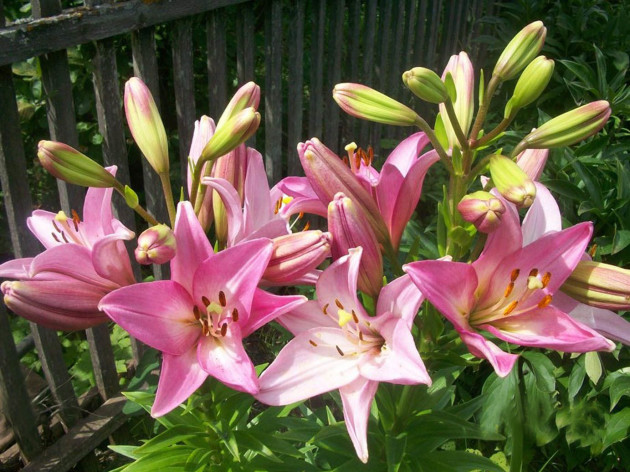
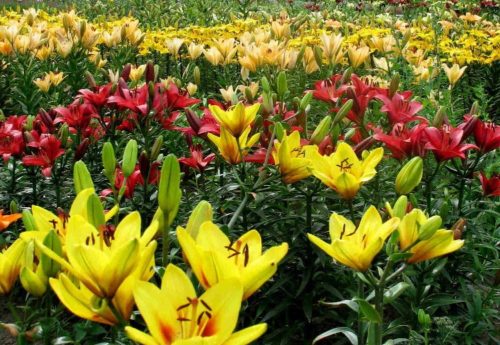

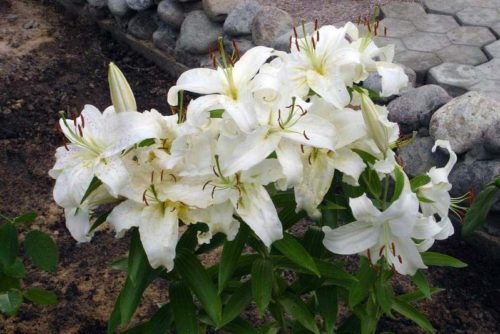
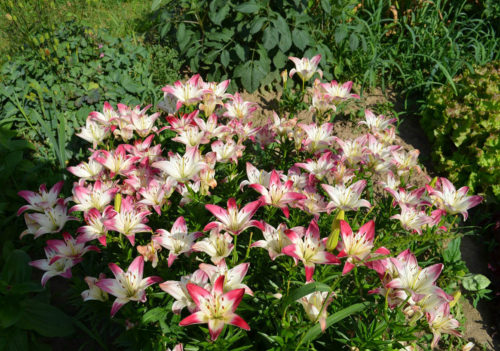
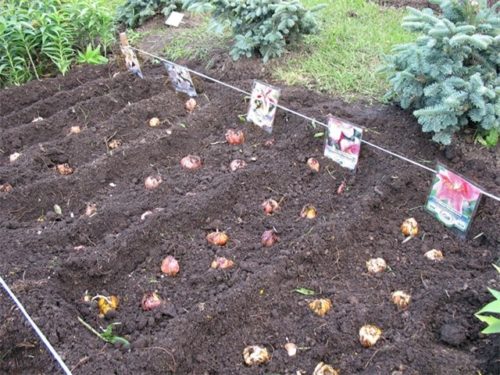
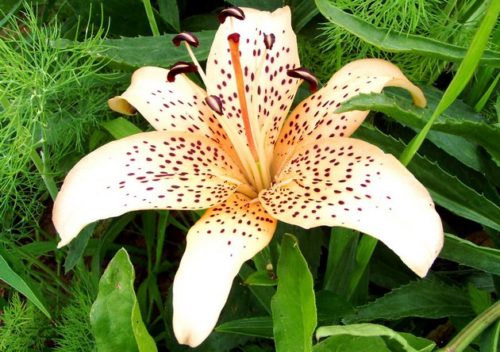
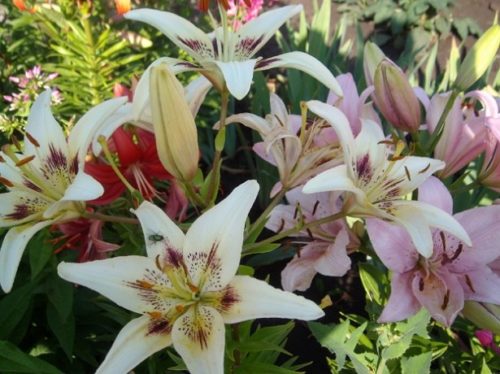
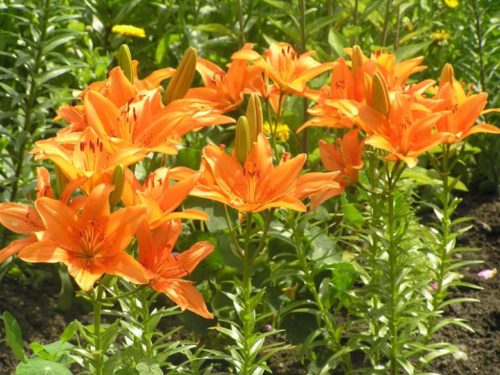
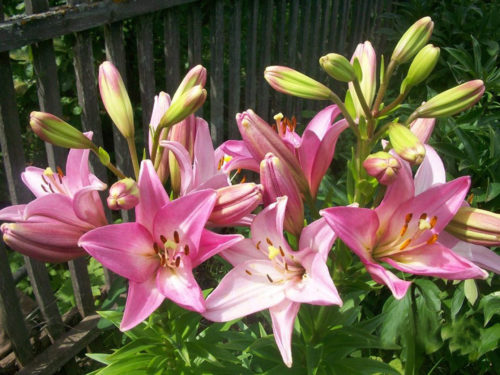
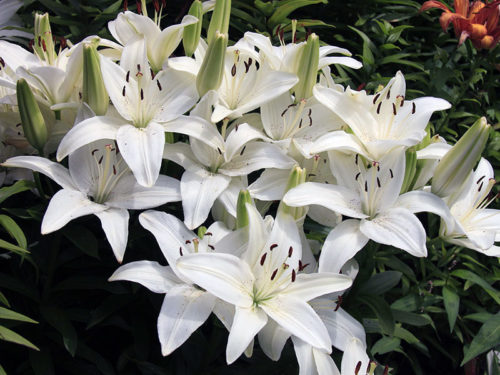












 Start a discussion ...
Start a discussion ...